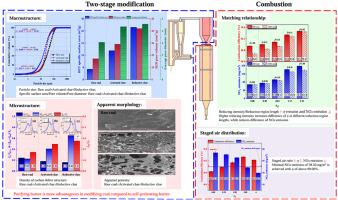Exploration on deep pulverized coal activation and ultra-low NOx emission strategies with novel purifying-combustion technology
IF 9.4
1区 工程技术
Q1 ENERGY & FUELS
引用次数: 0
Abstract
Under the strategic objectives of carbon peaking and carbon neutrality, increasingly stringent NOx emission standard was hard to meet in coal-fired boilers, and it was imperative to develop clean coal combustion technologies. As a novel combustion technology, purifying-combustion technology had good prospects in NOx emission reduction, and pulverized coal modification and modified fuel combustion occurred in purifying burner and down-fired combustor (DFC) respectively with this technology. The novelty of this study was associated with a first-time systematical analysis of the advantage of purifying burner in deep pulverized coal activation and the matching relationship of multistage combustion air in reduction region of DFC. Experiments were performed in 30 kW purifying-combustion test rig to investigate the two-stage modification characteristics of pulverized coal in purifying burner and the difference in influence of reducing intensity on combustion and NOx emission characteristics at different reduction region lengths and the influence of staged air distribution on them in DFC. Two-stage purifying burner demonstrated greater advantages in improving particle properties of pulverized coal compared to single-stage self-preheating burner: specific surface area, pore volume, pore diameter, density of carbon defect structure and fuel-N conversion rate increased from 19.01 m3/g, 29.15 mm3/g, 4.34 nm, 3.93 and 52.96 % to 34.39 m3/g, 42.49 mm3/g, 4.57 nm, 4.41 and 66.43 %, respectively. In DFC, increasing reducing intensity in reduction region or extending its length reduced NOx emission, albeit at the expense of combustion efficiency (η). Decreasing reducing intensity resulted in decrease of η difference and increase of NOx emission difference between different lengths. Staged air distribution in reduction region promoted clean and efficient combustion, and increasing staged air ratio to ∞ realized minimal NOx emission of 39.50 mg/m3 with η of 99.23 %.

新型净化燃烧技术的深煤粉活化和超低氮氧化物排放策略探索
在 "碳调峰 "和 "碳中和 "的战略目标下,燃煤锅炉难以满足日益严格的氮氧化物排放标准,发展洁净煤燃烧技术势在必行。作为一种新型燃烧技术,净化燃烧技术在氮氧化物减排方面具有良好的前景,净化燃烧器和下燃式燃烧器(DFC)分别采用该技术进行煤粉改性和燃料改性燃烧。本研究的新颖之处在于首次系统分析了净化燃烧器在煤粉深度活化中的优势以及多级助燃空气在 DFC 还原区的匹配关系。在 30 kW 净化燃烧试验台架上进行了实验,研究了煤粉在净化燃烧器中的两级改性特性、不同还原区长度下还原强度对燃烧和氮氧化物排放特性的影响差异,以及 DFC 中分级配风对其的影响。与单级自预热燃烧器相比,两级净化燃烧器在改善煤粉颗粒特性方面表现出更大的优势:比表面积、孔体积、孔直径、碳缺陷结构密度和燃料-N 转化率分别从 19.01 m3/g、29.15 mm3/g、4.34 nm、3.93 和 52.96 % 增加到 34.39 m3/g、42.49 mm3/g、4.57 nm、4.41 和 66.43 %。在 DFC 中,增加还原区的还原强度或延长其长度可减少氮氧化物的排放,但会降低燃烧效率 (η)。降低还原强度导致不同长度之间的η差减小,氮氧化物排放差增大。还原区的分段配风促进了清洁高效燃烧,将分段配风比增加到 ∞ 时,氮氧化物排放量最小,为 39.50 毫克/立方米,η 为 99.23%。
本文章由计算机程序翻译,如有差异,请以英文原文为准。
求助全文
约1分钟内获得全文
求助全文
来源期刊

Energy
工程技术-能源与燃料
CiteScore
15.30
自引率
14.40%
发文量
0
审稿时长
14.2 weeks
期刊介绍:
Energy is a multidisciplinary, international journal that publishes research and analysis in the field of energy engineering. Our aim is to become a leading peer-reviewed platform and a trusted source of information for energy-related topics.
The journal covers a range of areas including mechanical engineering, thermal sciences, and energy analysis. We are particularly interested in research on energy modelling, prediction, integrated energy systems, planning, and management.
Additionally, we welcome papers on energy conservation, efficiency, biomass and bioenergy, renewable energy, electricity supply and demand, energy storage, buildings, and economic and policy issues. These topics should align with our broader multidisciplinary focus.
 求助内容:
求助内容: 应助结果提醒方式:
应助结果提醒方式:


